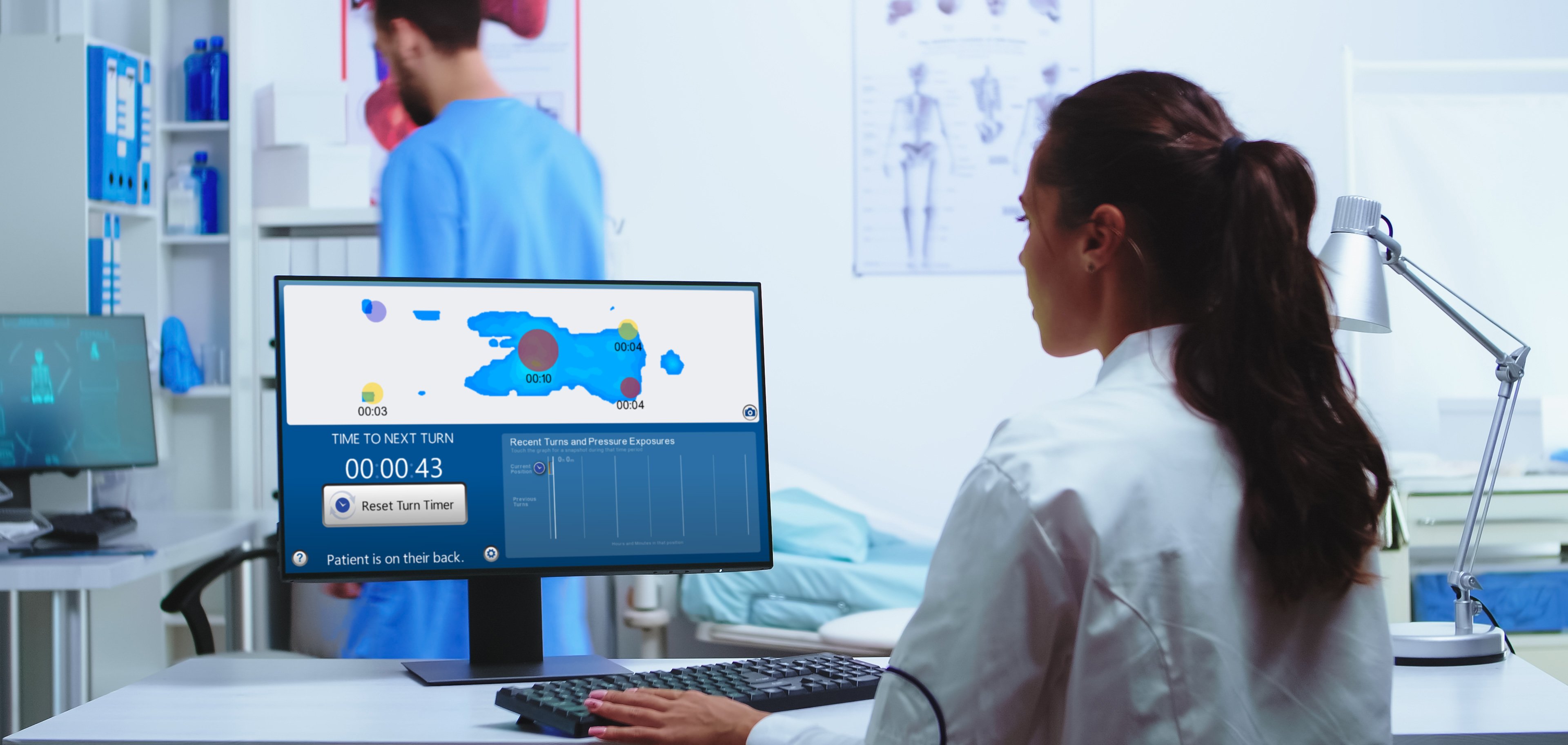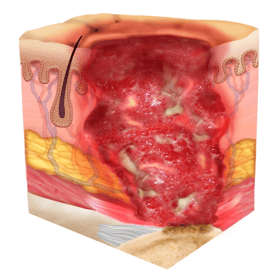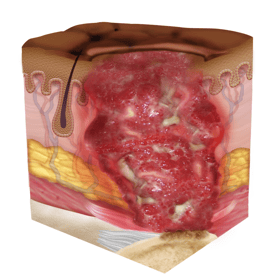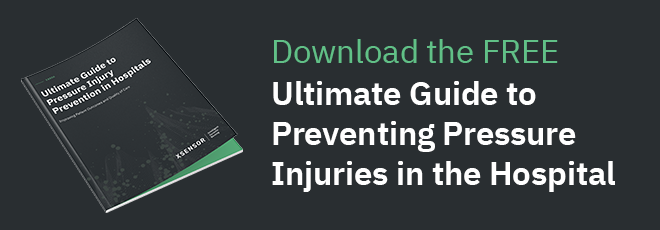
Pressure Injury 101: Stage 4 Pressure Ulcers
These are the signs of stage four ulcer development.
In hospitals and healthcare institutions worldwide, the topic of pressure injuries comes up frequently when discussing patient care and risk management. This makes sense. Pressure injuries (also known as pressure ulcers, bedsores or decubitus ulcers) have the potential to cause significant problems for both patients and healthcare professionals. In the United States, 2.5 million people experience pressure injuries each year, and 60,000 of those die annually. These particular injuries, also known as hospital acquired pressure injuries (HAPIs), can develop in hospital beds or in operating rooms. In fact, up to 45% originate on operating tables. (Berlowitz D, 2014, p.11) When left untreated, pressure sores can result in severe tissue damage and even death. These statistics offer a stark reminder that comprehensive treatment for pressure injuries is vital. And beyond that—prevention methods should be integrated at the beginning of patient care.
Over the last year, we’ve watched and learned as hospitals have undergone serious strain due to COVID-19. With staffing efforts redirected to address the virus, inefficiencies in routine patient care have become more obvious—particularly care that tends to be manual and labour-intensive, such as monitoring for pressure injuries. In a world grappling with this global pandemic, we have a responsibility to help alleviate pressure on our valued healthcare workers by integrating smart, sustainable technology that prevents injuries efficiently, with far less work required.
At XSENSOR, we create equipment that helps healthcare professions and patients avoid the dangerous effects of pressure sores by preventing their development in the first place. Our equipment is built specifically to assess, track and predict risk, remove pressure and help manage diagnosis and treatment. We’re working toward a future where pressure sore monitoring is no longer a strain on healthcare workers, and where patients never have to worry about them.
What are the stages of a pressure sore?
Pressure sores are injuries to the body caused by sustained pressure. Pressure sore severity can be categorized according to four main phases—from a stage one ulcer where the skin is just beginning to show damage, to a stage four ulcer with open wounds, sores and signs of infection. Whatever the stage, all should be taken seriously and treated with urgency. Here are the four stages of a pressure injury.
Stage 1 Pressure Injury and Ulcer: Early on in pressure ulcer development, the skin is developing injury. While no open sores or broken skin are present yet, skin may appear redder, warmer, firmer or softer than usual. Known as a non-blanchable erythema of intact skin, the color change may indicate the beginnings of a serious injury to the deep tissue.
Stage 2 Pressure Injury and Ulcer: This is where the true sore, or ulcer, develops as a break in the skin and an open sore. It is often very painful, and can create serious damage within the skin. Known as partial-thickness skin loss with exposed dermis, these bed wounds may present as a blood-filled blister and can quickly become something much worse.
Stage 3 Pressure Injury and Ulcer: In stage three, the pressure ulcer has developed into the soft tissue underneath the skin. Known as full-thickness skin loss, this stage may show a deep wound, especially in an area with more adipose tissue.
Stage 4 Pressure Injury and Ulcer: By the final and most serious stage of a pressure sore, the skin may have receded into the muscle and bone, causing lasting damage to the skin and underlying areas. Known as full-thickness skin and tissue loss, this stage can involve visible or palpable fascia, tendon, muscle and bone, and even dead tissue.
How to identify a stage four pressure ulcer

In a stage four pressure ulcer, you’ll see a marked difference from earlier pressure sore stages. During stage one, tissue injury may be hard to detect, while stage two reveals itself more obviously with an open sore. Stage three ulcers begin extending down into the soft tissue and start to signal deep tissue damage.
 At stage four, pressure ulcers involve a wound that has begun reaching into the muscle and even the bone. Compared to a stage one ulcer where you’ll merely suspect deep tissue injury, there will be no question by stage four. These are incredibly serious, and will usually show visible deep tissue damage, drainage, pus and a wound covered with a thin layer of eschar. These often become infected, and may require surgery to repair.
At stage four, pressure ulcers involve a wound that has begun reaching into the muscle and even the bone. Compared to a stage one ulcer where you’ll merely suspect deep tissue injury, there will be no question by stage four. These are incredibly serious, and will usually show visible deep tissue damage, drainage, pus and a wound covered with a thin layer of eschar. These often become infected, and may require surgery to repair.
Here are some signs to keep in mind when monitoring for a stage four pressure ulcer:
- The skin has developed a crater, and the wound bed may include visible adipose tissue, muscle or bone.
- The sore has a foul odor.
- The sore is oozing clear liquid, pus or blood, or showing other signs of infection.
- The sore may show skin that has turned black with dead tissue.
- The sore is large, deep and noticeable and may be covered by slough or eschar.
How to treat a stage four pressure ulcer
Stage four pressure ulcers require immediate wound care strategies, and can necessitate both surgery and serious antibiotics. Stage four bedsores are dangerous, and should be treated as such.
Step one of treating a stage four pressure ulcer would, ideally, have taken place at the beginning of the hospital stay with risk assessment technology. By using this technology at the outset, health care professionals are able to proactively mitigate development.
Next, health care staff should implement turning and pressure-relieving strategies to take additional pressure off of the wound, while keeping their mind on the bigger picture: when treating one pressure sore, they can’t give a new one opportunity to develop.
Every hospital or health care institution has wound care strategies included in their protocols, which should be implemented immediately. Irrigating and properly dressing the wound is essential, as are antibiotics if needed. Stage four pressure injuries may require surgery, and a pressure ulcer advisory panel may need to be considered.
Equipment to prevent stage four pressure ulcers
Pressure injuries and ulcers lead to significant challenges in hospital settings. When not identified and treated promptly, they cause unnecessary suffering (and are sometimes life-threatening) for patients. And since the efforts to prevent and mitigate them can be labour-intensive, pressure injury care can often lead to inefficiencies in health care settings, diverting valuable staff attention from other urgent situations.
By integrating technology that helps prevent ulcer development in the first place, your hospital can make great strides in improving patient care and boosting the efficiency of your staff. XSENSOR’s technology offers continuous pressure monitoring, giving medical professionals accurate, up-to-date data to help with the treatment and, ideally, the complete prevention of pressure injuries.
XSENSOR’s ForeSite technology is designed to help clinicians alleviate and prevent the formation and progression of pressure sores, helping you address three main culprits: surgical tables, hospital beds and wheelchairs.
- For hospital beds: Our unique ForeSite Intelligent Surface system has more than 1500 sensor cells on the surface of the mattress or overlay to measure patient body surface pressures, displaying data in real time for continuous monitoring. The system includes AI powered body position tracking and a turn clock to track repositioning that informs better patient care.
- For surgical tables: Our ForeSite OR system carries the same technology through to the operating room, which is excellent for safe positioning and managing risk in longer surgeries.
- For wheelchairs: Our ForeSite SS system utilizes high accuracy sensing to design safe seating for those in wheelchairs.
At XSENSOR, we’re working toward the same goal that you are: high quality patient care and positive experiences across the board. Our intelligent, dynamic sensing technology gives you the tools to do that work with excellence. Contact us today, and we’ll elevate your standard of care together.
References:
Berlowitz D, Lukas CV, Parker V, et al. (2014). Preventing pressure ulcers in hospitals: a toolkit for improving quality of care. Agency for Healthcare Research and Quality. https://www.ahrq.gov/professionals/systems/hospital/pressureulcertoolkit/index.html
Report typo or error by contacting XSENSOR


